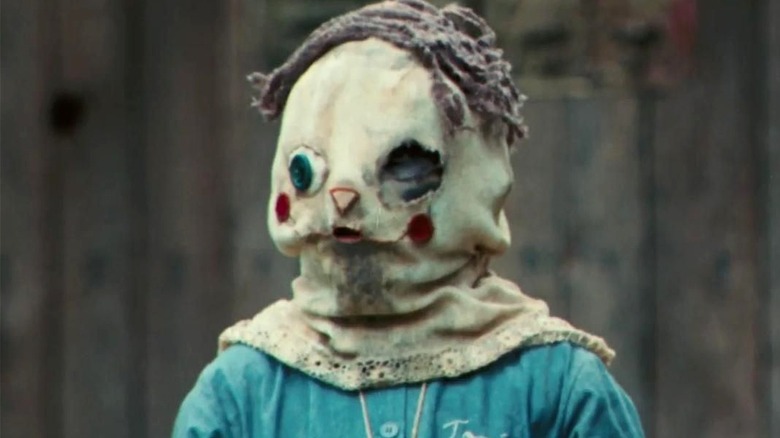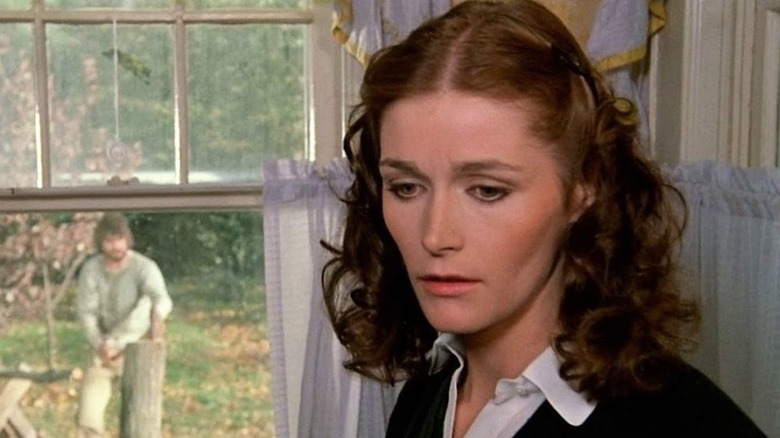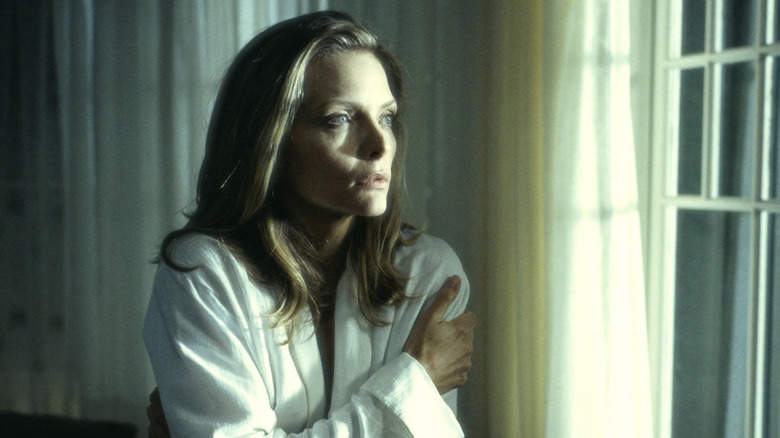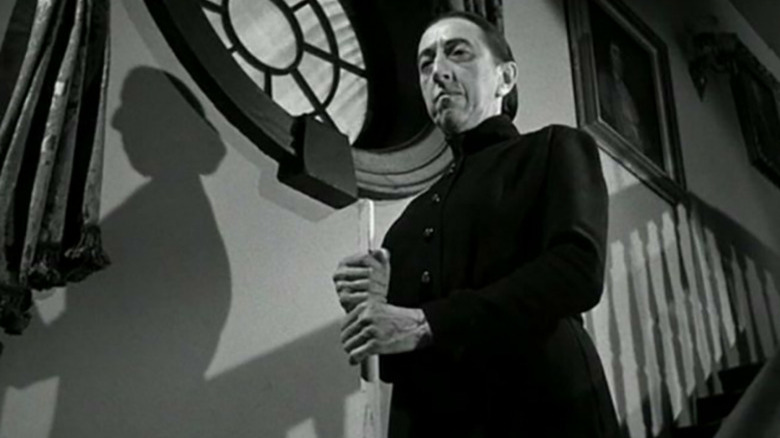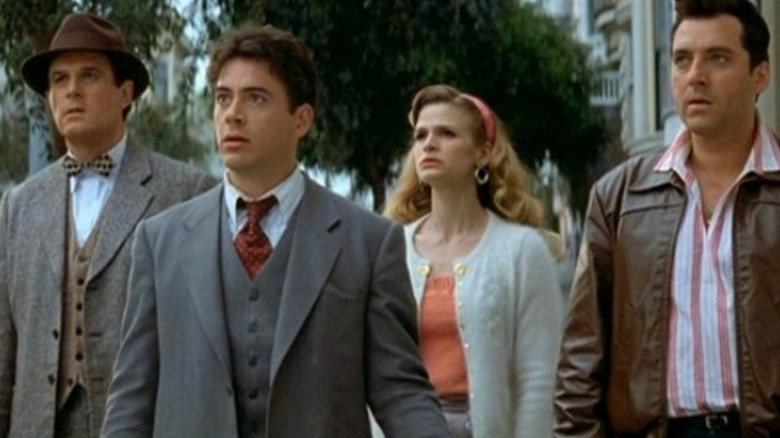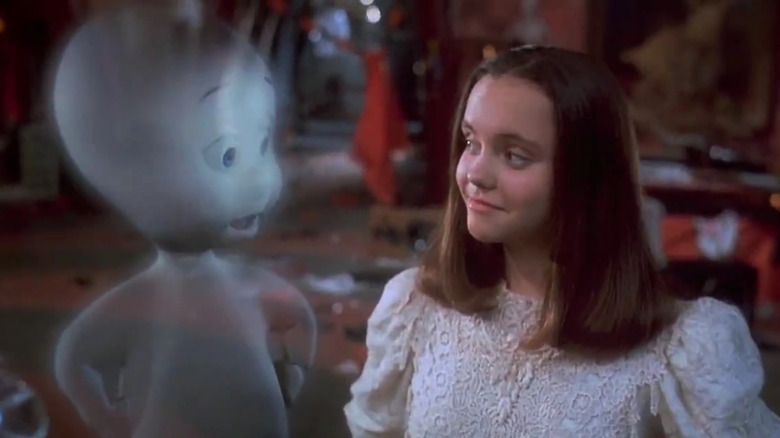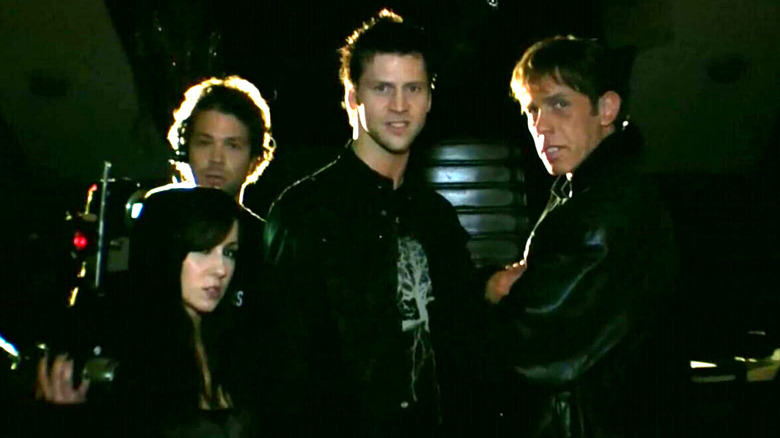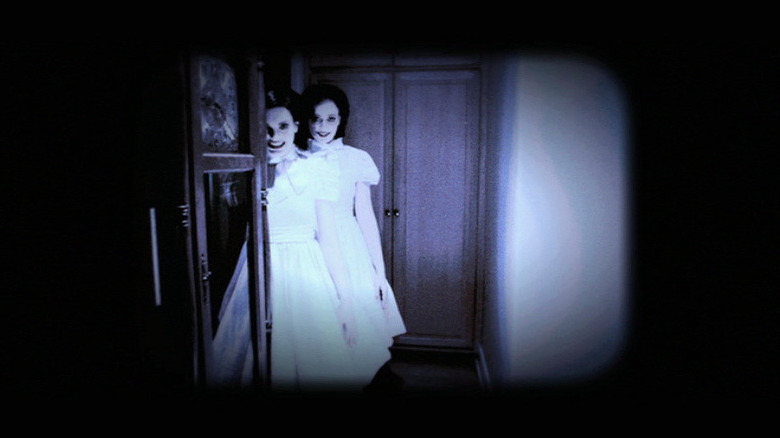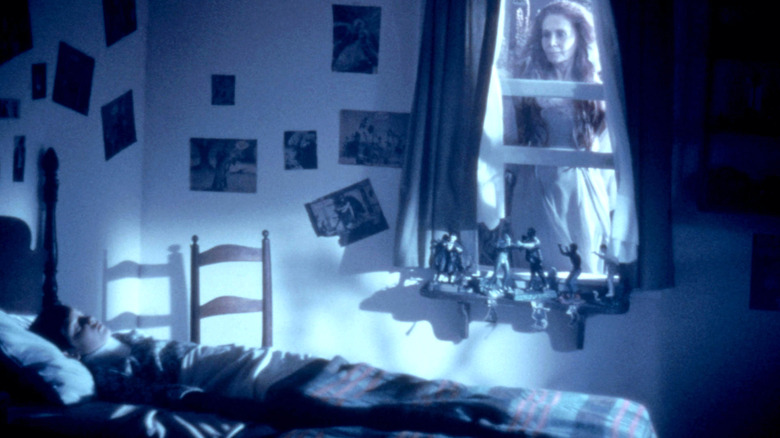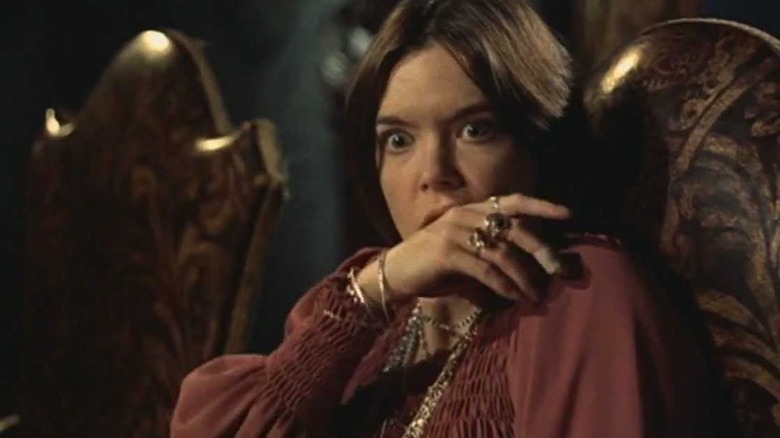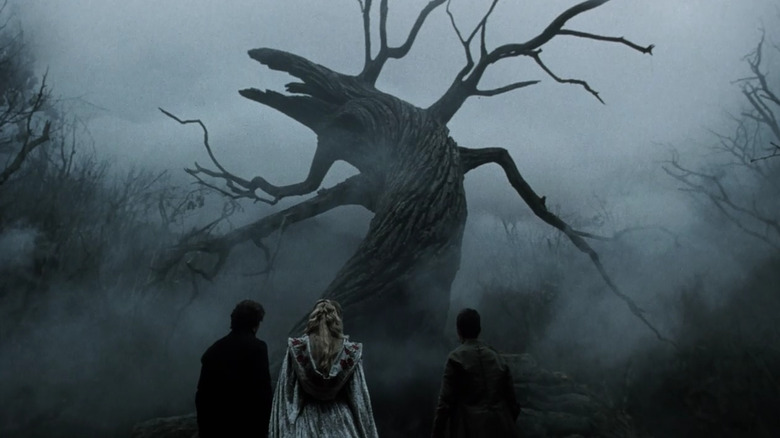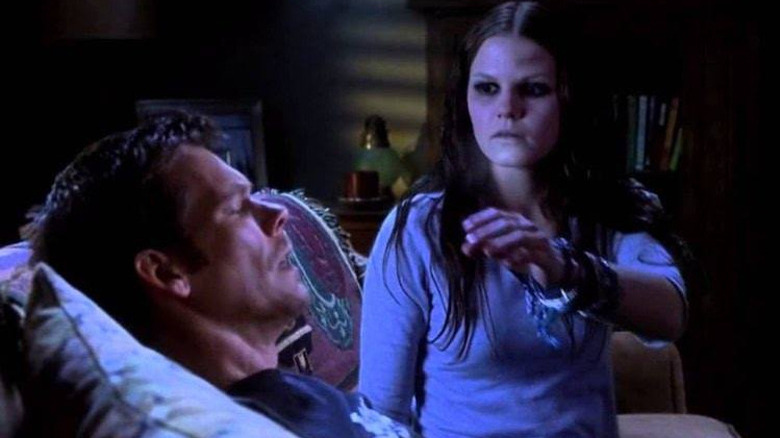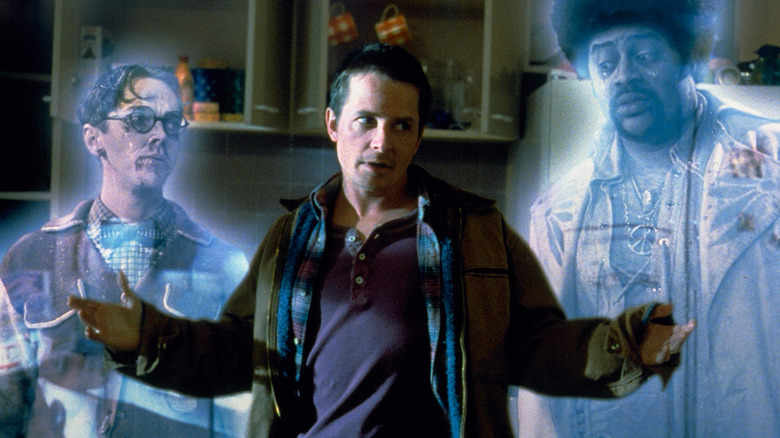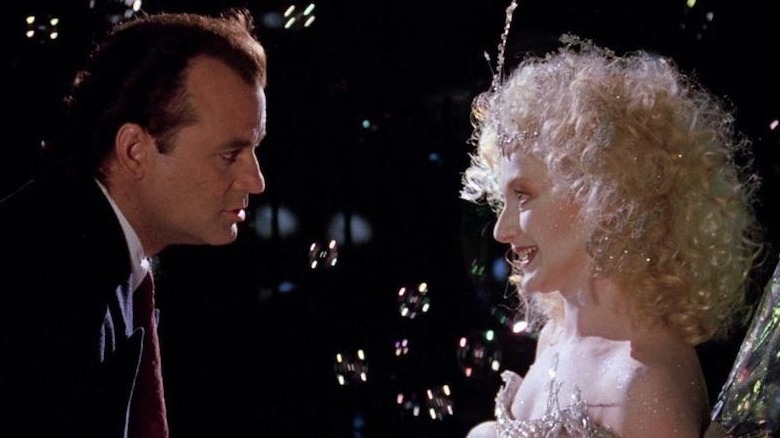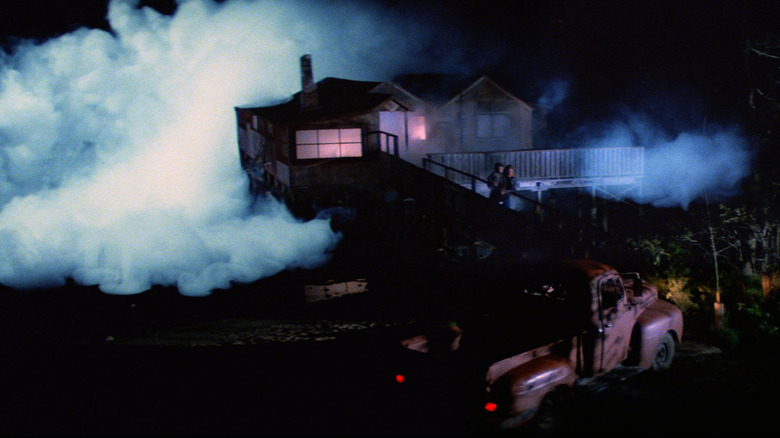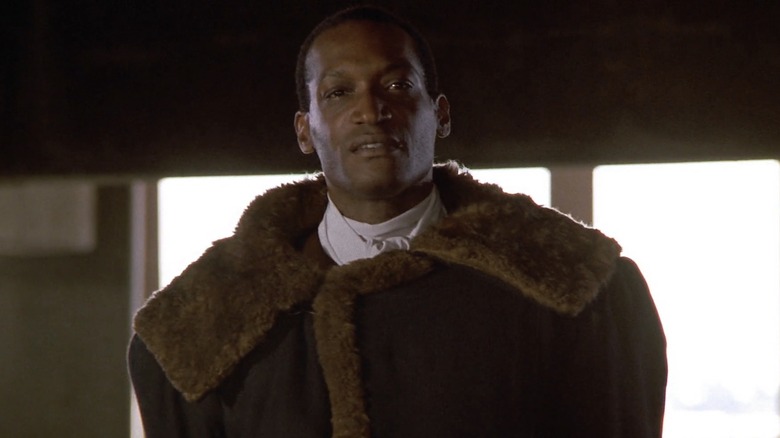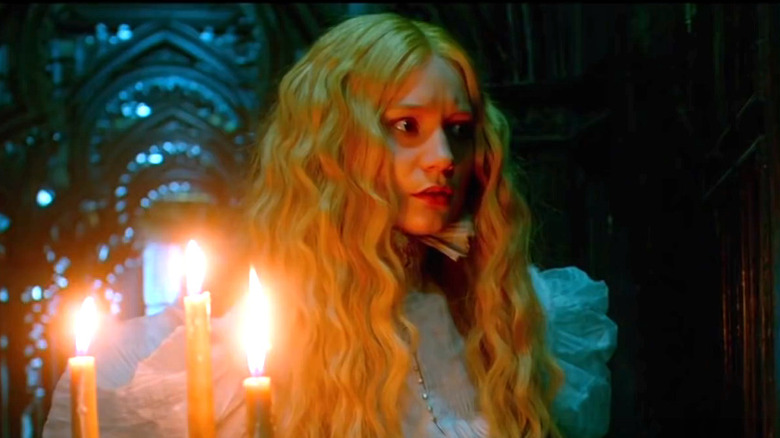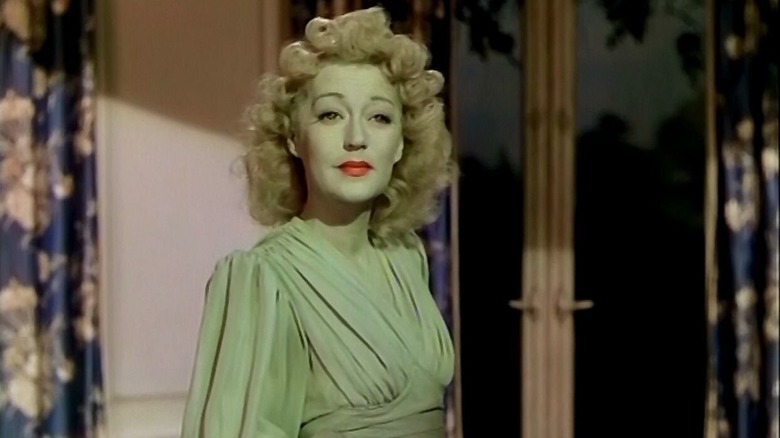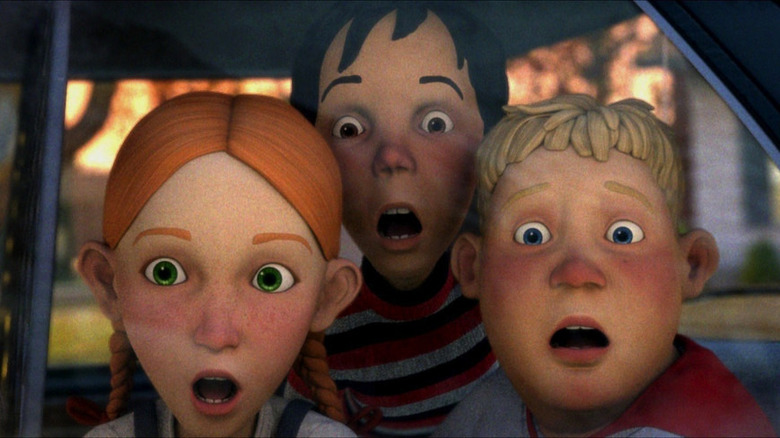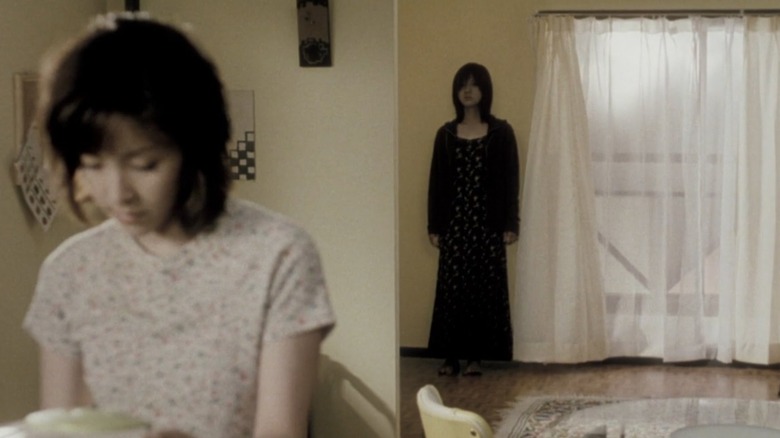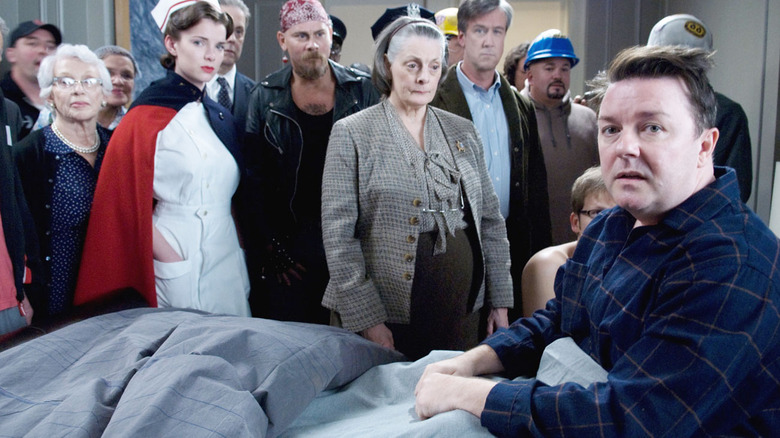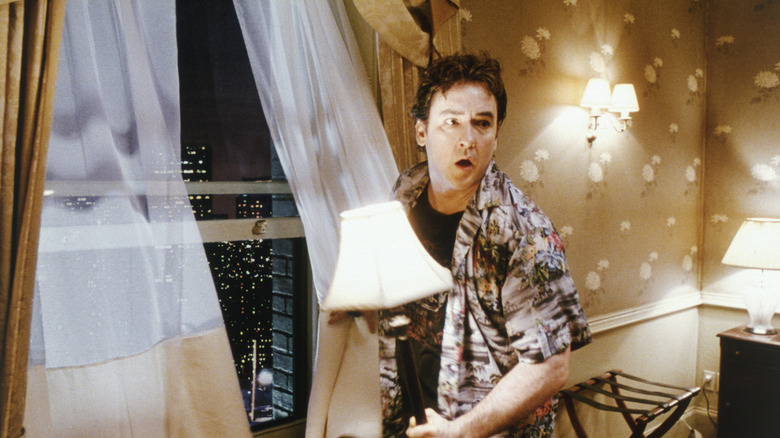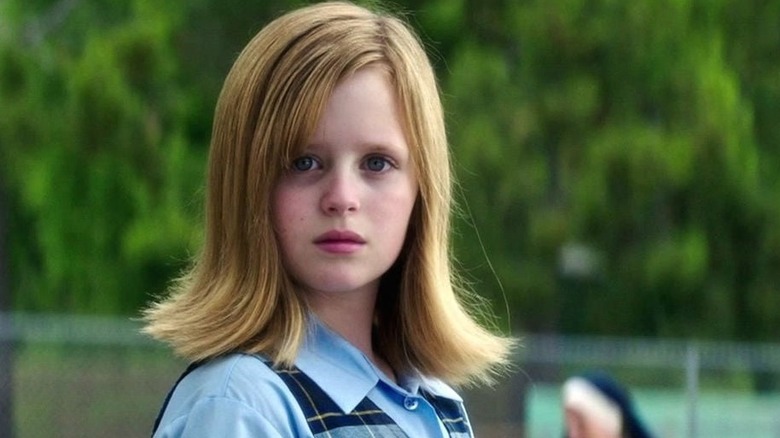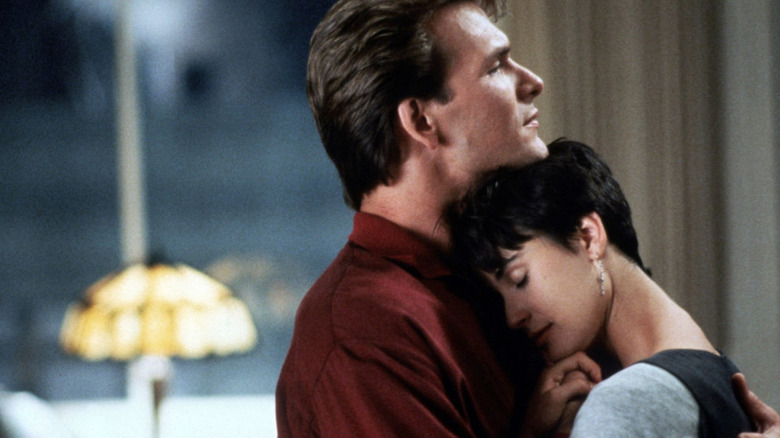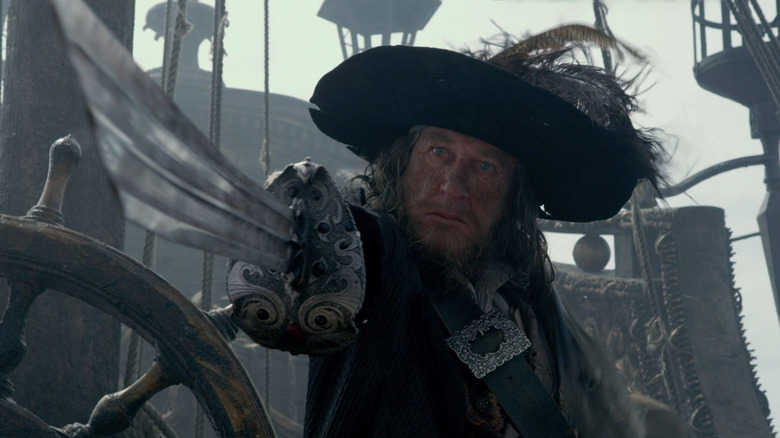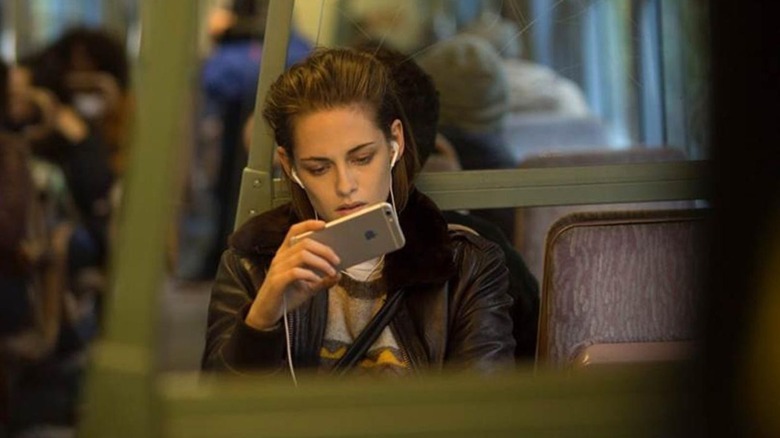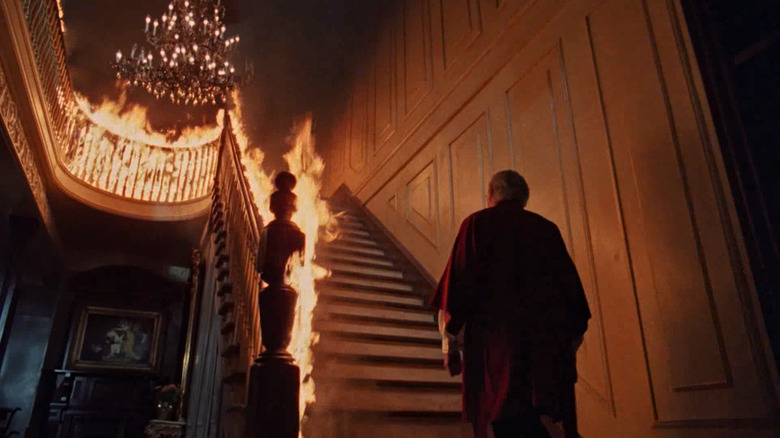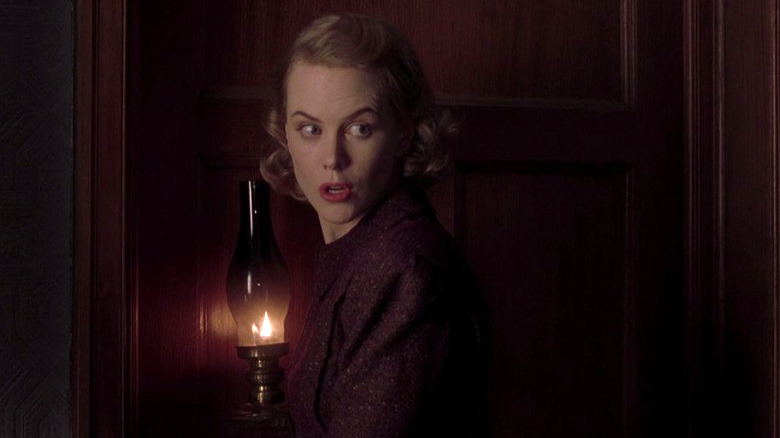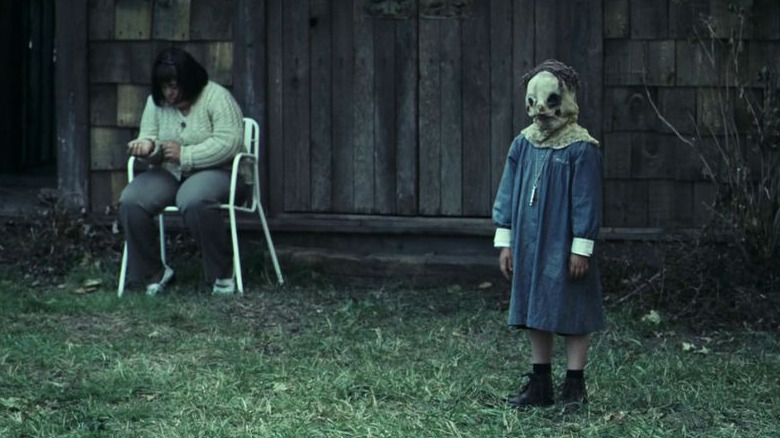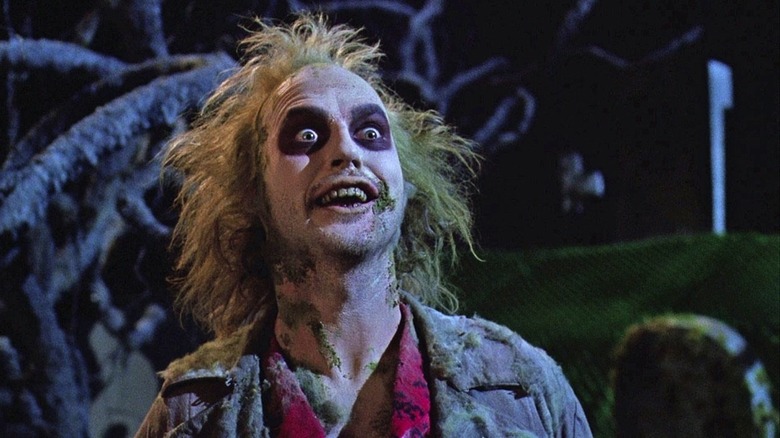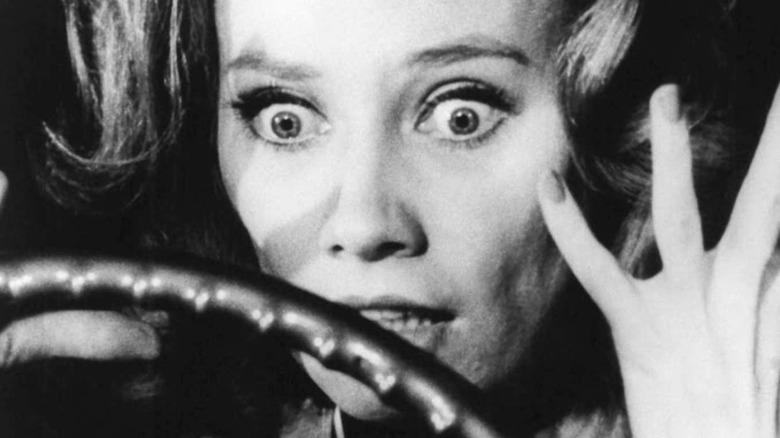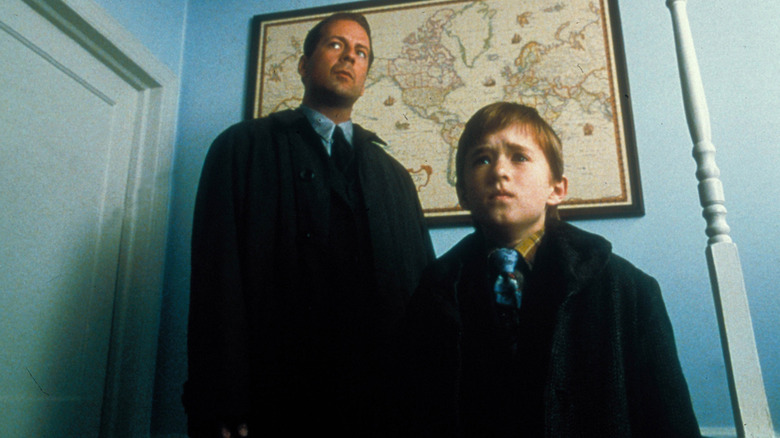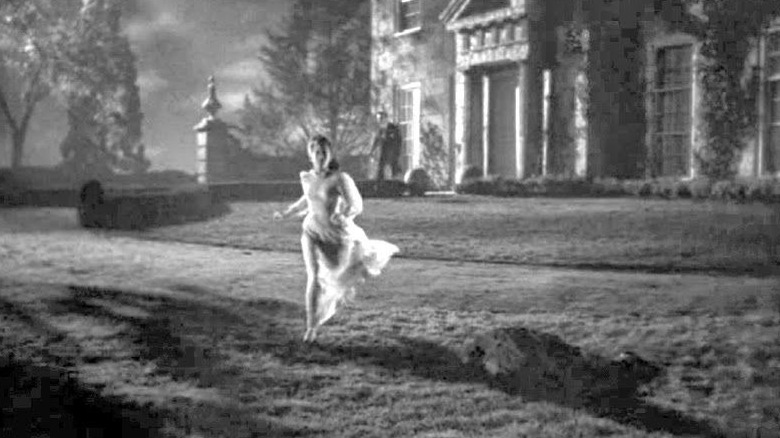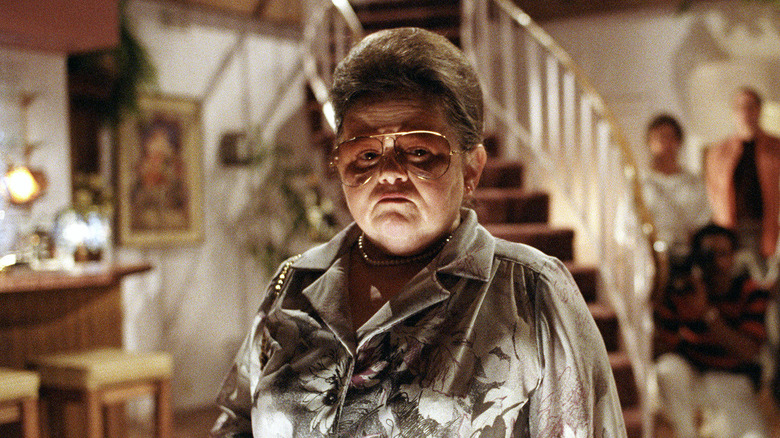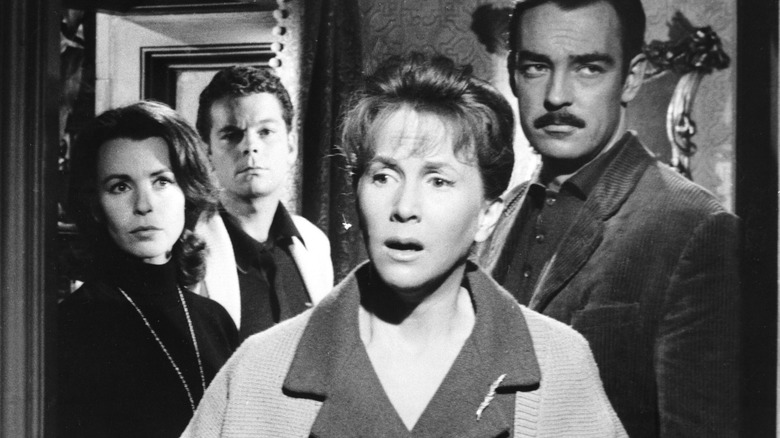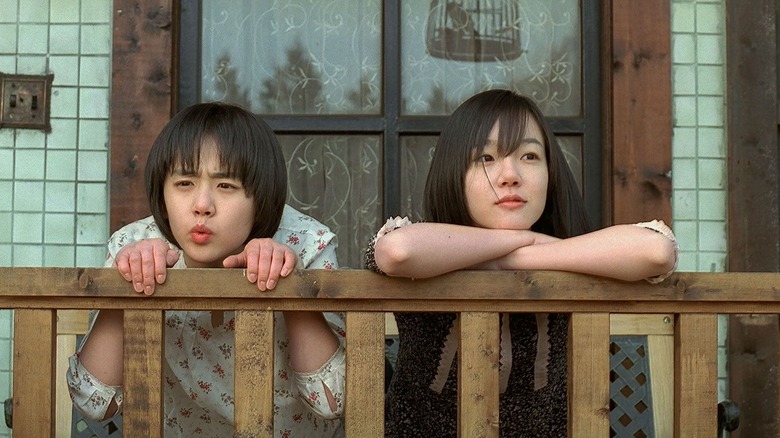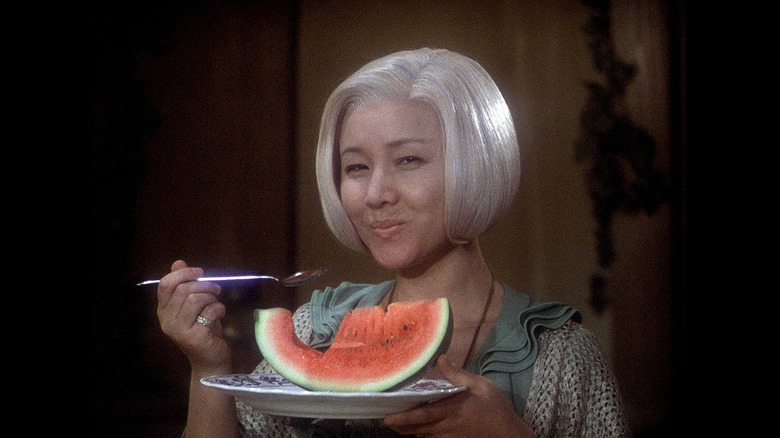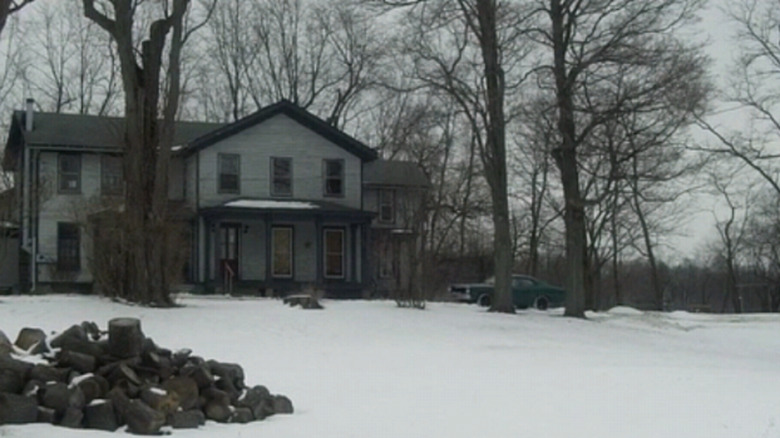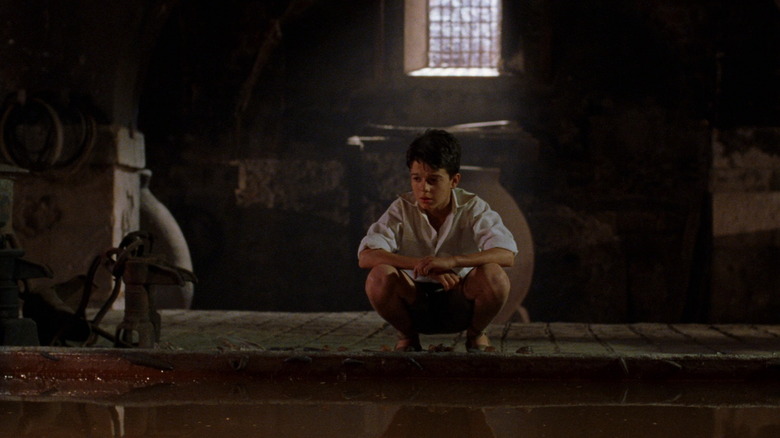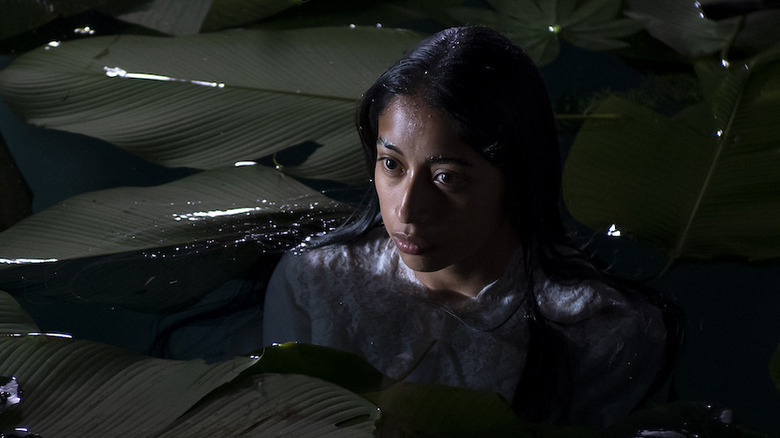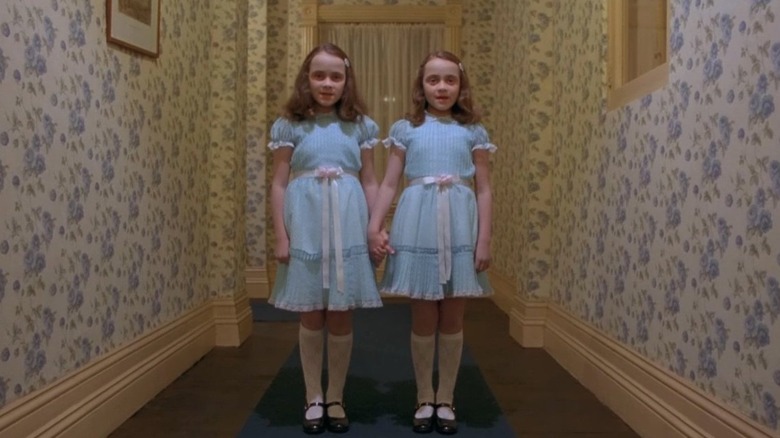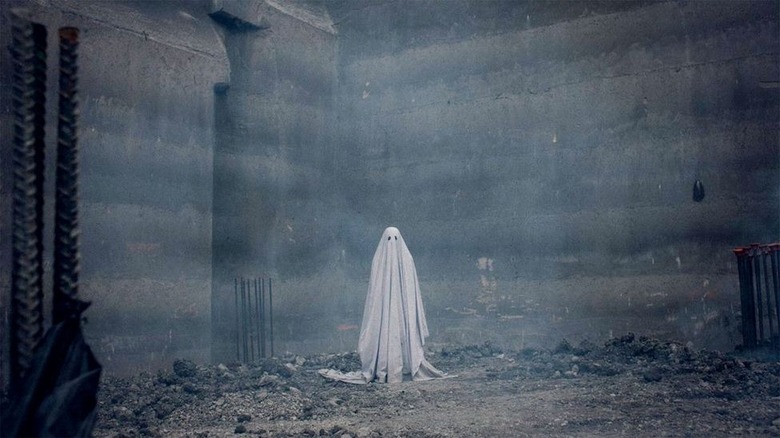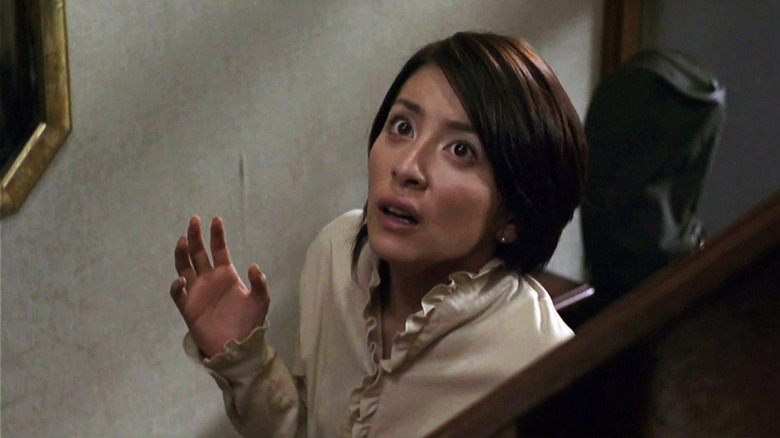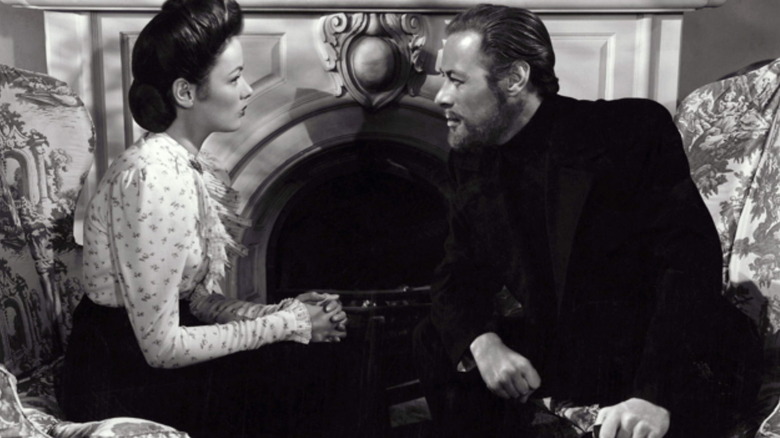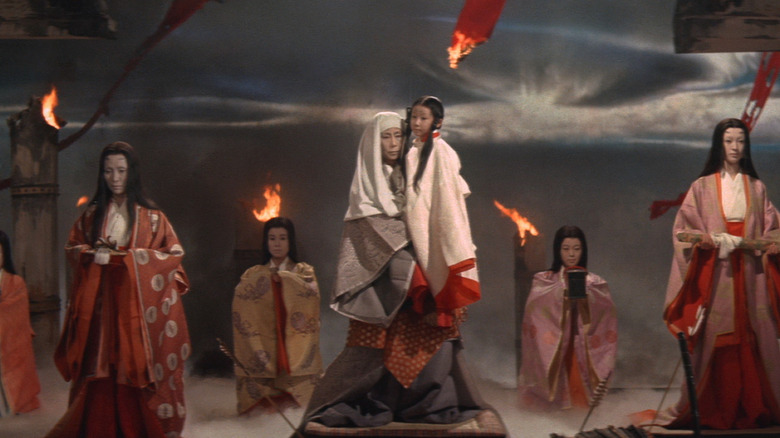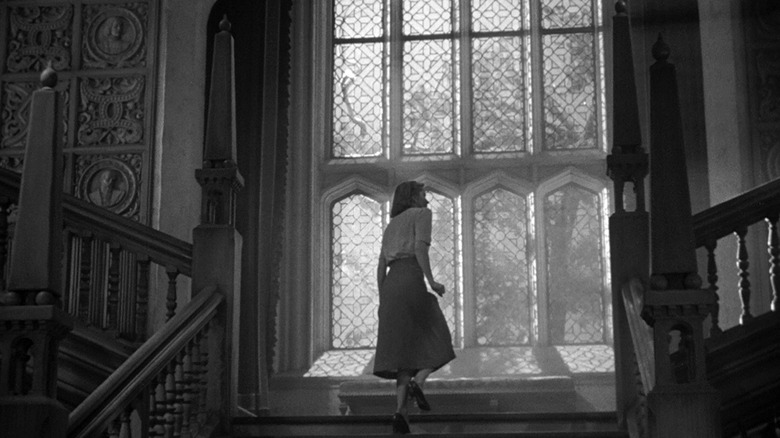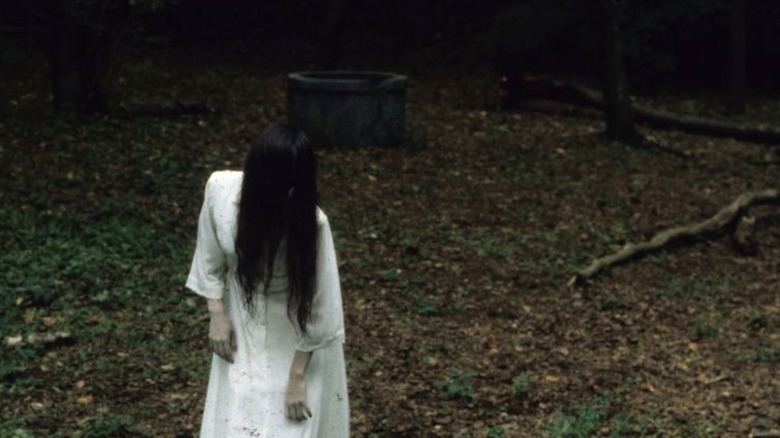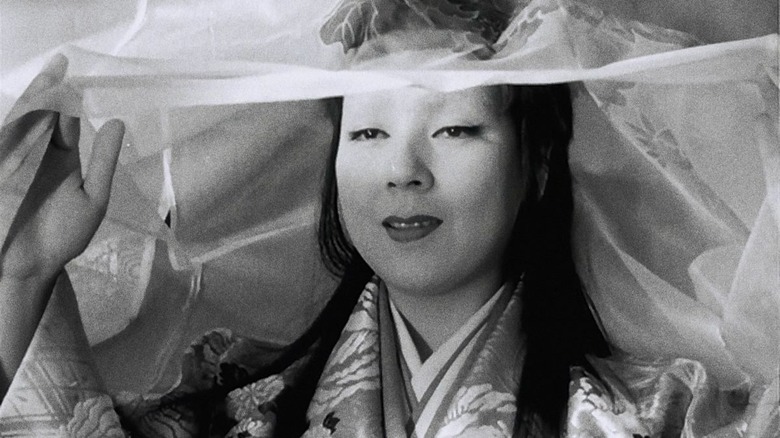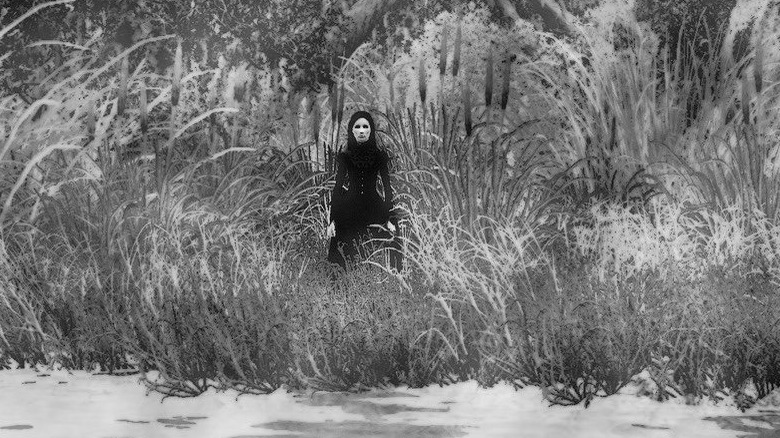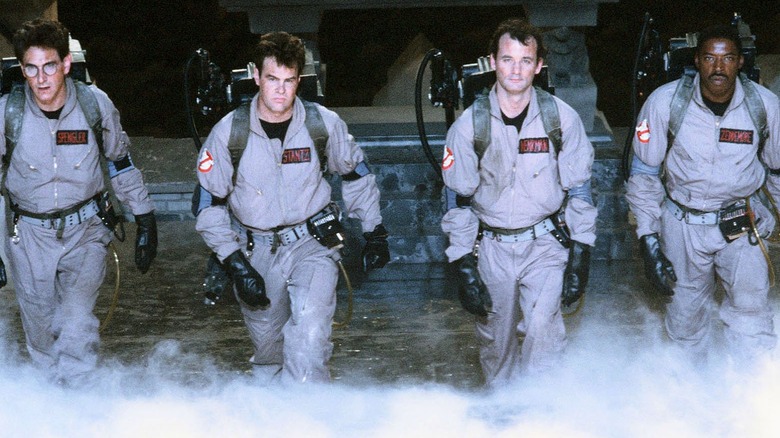50 Greatest Ghost Movies Of All Time Ranked
Ghosts, spirits that linger on unanchored to a human body, are powerful tools in storytelling. Although typically a staple of horror movies, ghosts can be deployed in any genre, serving as an emissary into dark topics audiences usually prefer to ignore. The concept of a ghost has been around seemingly forever: exorcized in ancient Babylon, used in classical Greek plays, featured in Shakespeare's works, and passed down as folklore.
Cinema has been an excellent form for ghost stories. You've probably encountered more movies about ghosts than you can count, from the Silent Era to the present day. With the help of rankings provided on Rotten Tomatoes and considering the cultural impact, with a sliver of personal opinion, we have ranked the 50 best movies about ghosts. While preferential treatment was shown to horror films, there is a blend of genres here.
49. The Amityville Horror (1979)
"The Amityville Horror" made a huge impact thanks to the reportedly true story making headlines years before. It also spawned a franchise that consists of several sequels and a remake. Nonetheless, it starts off the list due to the rather confusing aspects of the supernatural occurrences. At one point, it's stated that their house contains a doorway to Hell. So, the forces tormenting them could certainly be demonic, but inhabitants of Hell would likely include souls, right? Maybe some of the utterly bonkers activity going on could have been perpetrated by ghosts.
You probably know the story already: One year after a man murders his entire family at home, the Lutzes move into the house. Strange happenings lead them to believe there is something very wrong with their home. As its effect on them grows darker, the film ratchets up the horror until culminating in a final night that is worse than they could have imagined.
Aside from the questions regarding what exactly is haunting the Lutz family, this is still an effective piece of horror with imagery and scenes that stick in your memory, haunting you long after the credits have finished rolling.
48. What Lies Beneath (2000)
As we will see with later entries on this list, the concept of unfinished business is a popular trope in ghost stories. The idea is that spirits often stick around after death to take care of something they were unable to in life. Very often, the unfinished business has to do with their own murder, as it does in the supernatural thriller "What Lies Beneath" from director Robert Zemeckis.
Zemeckis, who dabbled in horror previously with episodes of "Tales from the Crypt" and the dark comedy "Death Becomes Her," tells the story of a woman named Claire (played by Michelle Pfeiffer) coping with her husband Norman's (Harrison Ford) affair by communing with the spirit of his dead mistress, although she isn't aware that's what she's doing until later in the film.
Although the film contains some legitimately creepy moments, its primary concern is the mystery surrounding the mistress' murder and Norman's involvement. While Pfeiffer and Ford turn in solid performances, the real star of the film is its atmosphere. The gorgeous Vermont setting, incredible house, and serene lake become eerie and unsettling as the story unfolds, successfully bringing the audience into the story and holding them tightly until the film's final moments.
47. 13 Ghosts (1960)
Discussing the films of William Castle can be difficult because they were designed to be experienced, not simply watched. The notorious showman treated his movies like carnival exhibitions. He wasn't so much a storyteller as he was a promoter. He didn't want you to sit passively and marvel at the wonderful narrative; he wanted to get you to jump up and scream. He didn't do this by crafting quality films that would go on to stand the test of time; he achieved his desired effect through gimmicks.
For "Macabre," he had audience members sign an insurance policy in case they died from fright. Buzzers were installed under select seats during screenings of "The Tingler" to convince audiences the creature from the film was after them. "House on Haunted Hill" featured a plastic skeleton flying out over the audience. The original "13 Ghosts" required viewers to put on special glasses referred to as supernatural viewers in order to see the ghosts on the screen.
While stunts like this usually have a short shelf life, several of his films, such as "13 Ghosts," are still fun to watch as a bit of retro fun. Is it scary? Not really. Does it reveal some profound insight into the human experience? Nope. It does, however, feature the greatest hits of horror movie cliches played up to their full, zany, and entertaining potential.
46. Heart and Souls (1993)
One of the first things you're likely to notice about the romantic comedy "Heart and Souls" is the incredible cast. While Robert Downey Jr. is the lead, the souls in question are played by powerhouses like the late Charles Grodin, Alfre Woodard (who reunited with Downey in "Captain America: Civil War"), Kyra Sedgwick, and Tom Sizemore. All of them are incredible actors who work exceptionally well together.
This is an unfinished business ghost story that offers several opportunities for Downey to show his acting chops. The four ghosts from 1959 who follow him around, almost serving as guardian angels, often step in to his body to achieve some of the aforementioned business and to help him fix his life. When they do, Downey has to essentially play a ghost pretending to be his character, leading to some solid physical comedy. While it may not be hilarious, the film is genuinely funny with a bittersweet tone that holds up years after its initial release.
45. Casper (1995)
Most of the time, "Casper" is a light-hearted and innocent little movie about a young girl (Christina Ricci) learning to accept change. After the death of her mother, Kat's father (Bill Pullman) immerses himself in his work, leaving her to grieve alone. Neither of them possesses the ability to communicate with each other regarding their mutual pain. When they move into a haunted house for work, Kat struggles to accept her new surroundings. Luckily, she meets a dead little boy who has such an intense crush on her that he's actually the one responsible for them moving here.
Usually, a plot about a ghost luring a girl to his home would be the plot of a horror flick. However, since Casper is a friendly ghost, it plays as cute and sad. There's a lot of that in this movie. "Casper" is actually a fairly dark film, when you think about it. Characters die and quickly return as cartoon ghosts, a man has his head completely turned around and he's still able to walk, and there's the entire film is predicated on the existence of a dead child. Good, family fun!
In retrospect, this is kind of refreshing. It isn't a film that ignores the reality of our mortality. If anything, it celebrates it. While the tone ranges from macabre to broad slapstick, it doesn't shy away from conversations regarding death. This, in its own way, seems healthy.
44. Grave Encounters (2011)
Found footage received a bad reputation thanks to a deluge of cynical filmmakers who didn't understand the format's potential. After the successes "The Blair Witch Project" and "Paranormal Activity," it seemed like anyone with a camera and half an idea thought they could make their own. Unfortunately, what these imitators lacked was any comprehension of why those films worked so well.
In 2011, when you couldn't escape found footage, "Grave Encounters" was a true diamond in the rough. Styled as the raw footage from a "Ghost Adventures"-style paranormal investigation series, the film sees greedy con artists investigating a haunted mental hospital. That alone is a fun idea, but what makes the film work so well is how it experiments with the concept as a commentary on manipulative "reality" television.
That would be enough to make it interesting, but it's elevated even further by subverting the audience's expectations in subtle but very effective ways. If found footage fatigue (or the film's mediocre trailer) stopped you from watching this underrated gem, give it a watch. You can skip the sequel, though.
43. Insidious (2010)
James Wan's 2010 film "Insidious" has no right to be this good. It is, in effect, a modern take on "Poltergeist," with its own intriguing mythology. The explanation as to why this couple suddenly finds themselves surrounded by beings from beyond the void isn't as simple as "their house was built over a burial ground." Instead, it's a bit more metaphysical and unique.
The concept of creepy kids has already been done to death, but Wan found a way to make it work in a whole new way. The film is packed with genuinely frightening scenes and images. There's the pacing man outside the window who suddenly appears in the child's room, the boy standing against the wall who is barely glimpsed as Rose Byrne goes about her daily routine, and those terrifying pictures of grinning ghosts who are omnipresent but rarely seen.
Wan went on to even greater success with "The Conjuring" and its shared universe of paranormal films, but the original "Insidious" still stands as a legitimately creepy, intriguing, and suspenseful supernatural chiller that holds up on repeat viewings.
42. Lady in White (1988)
At first glance, "Lady in White" appears no different than other '80s films with kid protagonists. The opening credits are eerily idyllic, almost cozy, and the idea of a child communicating with the spirit of a girl his age certainly sounds like something Steven Spielberg might have attached his name to as a producer. Where this film differs from the likes of "E.T. the Extra-Terrestrial" and "The Goonies" is in its tone and the specifics of the plot.
This isn't a gender-swapped take on "Casper." This is a dark, melancholic supernatural murder mystery. Murders don't happen off-camera only to be discussed later in soft detail; in the first act, you see a girl being strangled. Yes, the strangulation is a form of repetitive haunting, so it doesn't have the same impact as watching a murder in real time, but it is harrowing. Minutes later, the boy witnessing this haunting (a pale, wide-eyed Lukas Haas) is also strangled, though he survives. It is deadly serious.
While it may not have become the cultural touchstone other films of the decade became, it does linger with you, as all great ghost stories should. For anyone who grew up watching this on cable, the nightmare-inducing scenes of the ghostly Lady in White standing outside the protagonist's window are likely still lodged in their subconscious.
41. The Legend of Hell House (1999)
Two things are made very clear within the first 10 minutes of this big-screen adaptation of Richard Matheson's novel: 1) This will not be a slow burn, and 2) Hell House is definitely haunted.
The film wastes no time getting the plot rolling. A doctor is tasked with investigating Hell House. He is assigned a small team consisting of two mediums and his own wife and they're off. What we learn about Hell House is that the man who owned it was really into debauchery and the occult. This means that the nature of the haunting is typically sexual and violent.
As Matheson (who adapted the novel himself) did with the vampire mythology in his novel "I Am Legend," he attempts to provide a scientific explanation for hauntings. He does this to amplify the phenomena and make them more realistic. Unfortunately, it's not as successful here because he assumes the viewer is familiar with these concepts and takes very little time to elaborate.
At its core, "The Legend of Hell House" feels like a teenager's version of what they think Shirley Jackson's "The Haunting of Hill House" should have been. The violence and eroticism are overblown, the characters underdeveloped, and the science is half-baked. None of that is to say the film is bad. In fact, its flaws and the atmospheric cinematography make it incredibly entertaining and worth a watch.
40. Sleepy Hollow (1999)
Washington Irving's "The Legend of Sleepy Hollow" isn't a terribly exciting story. The author takes his time establishing the beauty of the village in which it takes place and detailing Ichabod Crane's personality, but the horror elements we've come to associate with the tale don't arrive until much later. The prose is all about establishing the proper atmosphere before the final payoff.
Tim Burton's film "Sleepy Hollow" is certainly atmospheric, but it ignores the long, detailed setup to tell a funny, exciting, and uncharacteristically gory mystery. In this version, the Headless Horseman isn't an elusive and mysterious phantom, he is a tool of destruction wielded by an angry and bitter individual. He stalks his prey like a silent slasher before brutally murdering them and taking their heads back to his sacred tree.
The only way to truly enjoy the film is to ignore logic, give only the slightest attention to plot, and simply soak up the imagery. As Peter Travers stated in his Rolling Stone review, "Even when the narrative stalls from too many detours and decapitations, 'Sleepy Hollow' is gorgeous filmmaking that brims over with fun-house thrills and ravishing romance."
39. Stir of Echoes (1999)
Another adaptation of a Richard Matheson novel, this time handled by frequent Spielberg collaborator David Koepp, "Stir of Echoes" is a gripping murder mystery with a flawed, unintentional hero at its center.
Released the same year as M. Night Shyamalan's "The Sixth Sense," it doesn't pack the same emotional punch, but is equally well crafted and intelligent. Opening with a creepy scene of a young boy having a conversation with someone we cannot see and asking the question, "Does it hurt to be dead?" it certainly feels like another "Sixth Sense," but it's soon revealed that the focus is actually an adult, Tom Witzky (Kevin Bacon).
Witzky is a working-class guy who makes the mistake of allowing his sister-in-law to hypnotize him, awakening latent abilities. Following the hypnotism, Witzky begins having visions of a murder that occurred in his house. He becomes obsessed with discovering the truth. As the mystery unfolds, we can't help but identify with his determination.
For the most part, "Stir of Echoes" is a pretty standard movie with a few surprises. It may not be an earth-shattering masterpiece, but it is very well made and deserves to be talked about more.
38. The Frighteners (1996)
Before Peter Jackson was winning Academy Awards for "The Lord of the Rings: The Return of the King," he was mostly known for his work in the horror genre—specifically, his extreme splatter flicks, like the gross-out alien invasion movie "Bad Taste," the bonkers and raunchy puppet film "Meet the Feebles," and the unhinged gorefest "Dead Alive." In 1994, he successfully tried his hand at magical realism with "Heavenly Creatures," a stylized account of the very real Parker-Hulme murder case.
He could have easily continued down the dramatic path, but 1996 saw a return to horror (albeit with a much slicker look thanks to a Hollywood budget) with the hilarious and thrilling film "The Frighteners." Starring the always-charismatic Michael J. Fox as a medium who exploits his ability to communicate with the dead for financial gain, the film is a powerhouse of comedy and creativity.
Quite frankly, "The Frighteners" is a blast. The jokes don't always land, but it moves with such a fevered pace that you don't mind. The performances are stellar, with Jeffrey Combs as a quirky FBI agent being the real standout. Also, the film cleverly deploys computer technology to allow the ghosts to interact with the real world and to craft a suitably creepy villain.
37. Scrooged (1988)
When compiling a list of ghost movies, you have to include at least one adaptation of the Charles Dickens classic "A Christmas Carol." However, there are so many to choose from that the entirety of the list could be made up of the various adaptations. That's where personal choice and cultural perspective come into place. The 1988 Richard Donner film "Scrooged" won out over all the others simply for its creative and meta take on the material.
Not only is this film about a greedy curmudgeon who is visited by three ghosts who show him the error of his ways, but it also takes place in a world where Charles Dickens' story exists. The main character, played by Bill Murray, is actually overseeing a live production of the story to go out on Christmas. This allows the film to comment on the source material while honoring it at the same time.
The cast is phenomenal, Danny Elfman's score is magical, and the satire still packs a lot of bite. Of course, as great as the entire film is, it's that last moment when Bill Murray pleads with the audience to feel the Christmas cheer all year round that makes this film the uplifting classic it is.
36. The Fog (1980)
Two years after the original "Halloween" popularized the slasher film as we know it, John Carpenter made "The Fog," a classic ghost story set in an island town. While the film struggles to capture the same kind of tension and suspense Carpenter achieved in "Halloween," it does create an atmosphere that almost seems to seep its way off the screen.
The narrative is a little all over the place with several point-of-view characters, making it feel like an adaptation of a story Stephen King never wrote. This is one of the film's weaknesses, as it would have been far more engrossing to follow one character. They're all interesting and find themselves in unexpected situations once the malevolent fog rolls in bringing the ghosts of dead pirates with it, but jumping back and forth between them kills some of the momentum.
Aside from its structural shortcomings, the film has some real highlights. Dean Cundey's cinematography is always immersive and captivating. Seeing Janet Leigh in a film alongside her daughter Jamie Lee Curtis is a lot of fun. Then, of course, there's John Carpenter's mesmerizing score. Music is always important in film, but for John Carpenter movies they're crucial. In the case of "The Fog," it's the score that makes the movie truly great.
35. Candyman (1992)
Speaking of wonderful scores, Philip Glass' theme music for the 1992 film "Candyman" (titled Helen's Theme) is heartbreakingly gorgeous. It perfectly defines the nature of the film. With a title like "Candyman," one could easily assume this was nothing more than an attempt at inventing a new movie monster in the vein of Jason or Freddy. Instead, this adaptation of a Clive Barker short story is much more cerebral, mythic, and tragic than that.
Although the 2021 sequel does a much better job at discussing some of the themes introduced here, the original still stands on its own as a beautiful and grotesque gothic experience. From cinematography that makes Chicago look like something out of a damaged fairy tale, to the art direction exploring the dichotomy between modernity and myth, to Tony Todd's riveting performance, "Candyman" is a ghost story with much more to offer than the standard thrills and chills.
As Michael Rechtshaffen with The Hollywood Reporter said in his review, "This Candyman can elicit some bona fide shivers while the picture that bears his name is high-caliber horror in its purest, most primal form."
34. Crimson Peak (2015)
From one example of gothic horror to another, Guillermo del Toro's "Crimson Peak" is a huge, lavish, and twisted romance full of beautifully hideous creations, per the filmmaker's trademarks. There aren't many scares in this haunting period piece, but that's not always the intent with a dark ghost story. As we said before, ghosts can serve many purposes in a narrative, and "Peak" is an example of the supernatural being used as a metaphor for secrets and regret.
Edith (Mia Wasikowska) marries an inventor named Thomas Sharpe (Tom Hiddleston), who lives with his sister Lucille (Jessica Chastain). Edith is warned by a ghost to beware of something called Crimson Peak early in the film, but she doesn't listen. She relocates to the Sharpe's manse, Allerdale Hall, which stands atop and is sinking into a red clay mine, aka Crimson Peak.
Like many gothic romances, the truth of her relationship is much more complicated and the mystery she uncovers is much darker and stranger than even the audience can anticipate. The film makes this list thanks to the sheer beauty of its artistry and striking depiction of ghosts. The film manages to feel like a classic story you've known all your life while also being fresh and new.
33. Blithe Spirit (1945)
1945's "Blithe Spirit," from the play by Noël Coward, has the kind of premise that makes one think they know exactly what they're in for before the story begins. It's about a writer who hosts a séance at his home as research for his new book. At first, it seems as though the séance was unsuccessful, but then the author's late wife Elvira walks in. Naturally, this leads to bitterness and jealousy between Ruth, his current wife, and himself. While that is true, the story takes some truly strange twists along the way.
For the most part, the three leads of the film are selfish twits. Charles, the writer, never really appreciated either wife and finds his current predicament amusing. Elvira was an unfaithful showboat who held everyone in contempt. Ruth only cares about how others see her. That should make for an unlikable story, but all of it is played for laughs, and most of the comedy still works.
While everyone is good in the movie, Margaret Rutherford steals the show as the eccentric medium Madame Arcati. From the moment she arrives, she captures your attention and rewards you with an energetic and charming performance. Arcati is pleasant, courteous, and just batty enough to keep you smiling.
32. Monster House (2006)
The haunted house is the backbone of any ghost story. Although houses are nothing more than building materials placed together to provide shelter, humans pin their identities to them. Perhaps that's why the sight of an abandoned house often makes us feel so uneasy. Lives were lived there, but now it is a shell haunted by memories. Many stories use ghosts as a metaphor for memories, suggesting it is the emptiness in what was once a place of joy that makes a house haunted.
This is not the case with the 2006 animated horror-comedy "Monster House." There is something very wrong going on at the house in question, and there's nothing metaphorical about it. The house itself is possessed by a former occupant. Not only that, but this ghost is angry. It lashes out at anyone who dares trespass, particularly children, making it a dangerous place to go trick-or-treating.
"Monster House" should be on anyone's Halloween watchlist alongside standards like "It's The Great Pumpkin, Charlie Brown" and "Hocus Pocus." It is that inventive, funny, and good.
31. Pulse (2001)
In order to keep telling ghost stories without them getting old, you have to try and reinvent them a little bit. A subtle tweak here and there can go a very long way. Writer/director Kiyoshi Kurosawa brought a unique perspective to the concept of ghosts in his 2001 film "Pulse" by evolving them for the 21st century.
This film posits that the world where ghosts reside is finite and, if it gets too full, the ghosts will have to start inhabiting our world. That is an interesting enough take on ghost mythology to justify the film's existence, but Kurosawa takes things a step further by suggesting human beings, in their isolated worlds desperate to connect with one another, are ghosts already.
For a movie that was made in the relatively early years of the internet boom (one protagonist barely understands how to operate a computer), it is eerily prescient about what our digital lives would become. We spend all our time online, communicating with others, but never truly connecting—just like ghosts damned to silently wander the mortal realm alone.
30. Ghost Town (2008)
David Koepp makes his second appearance on this list, this time with a very different kind of ghost movie than "Stir of Echoes." "Ghost Town" is a romantic comedy about a man named Bertram Pincus (Ricky Gervais) who can communicate with ghosts after briefly dying while under anesthesia. The film falls into the unfinished business category of ghost movies, as these spirits are desperate for him to help them resolve their respective unfinished business.
One ghost in particular, played by Greg Kinnear, wants Bertram to stop his widow (Téa Leoni) from marrying someone new. Bertram agrees but falls in love with her himself. It's a fun way of subverting the rom-com trope of two people coming together under false pretenses. We've seen what happens when people start dating because of a bet or because of a little sociological experiment, so this is a fun little twist that keeps the narrative fresh.
It's also a nice change of pace for Gervais, who usually plays sardonic and selfish characters. In this film, he's just a lonely dentist who needed to die to learn how to live. The film won't change your life, but it will keep you smiling for the majority of its runtime.
29. 1408 (2007)
With all the stories Stephen King has published, you might think there'd be no need to adapt more than one with a similar premise. After the initial failure and later success of Stanley Kubrick's "The Shining" and King's own 1997 TV mini-series adaptation, there's really no sense in making another Stephen King film set in a hotel. Director Mikael Hafstrom did it anyway and, thanks to a great script by Matt Greenberg, Scott Alexander, and Larry Karaszewski, the result is a solid, entertaining, and suspenseful little horror movie.
The premise is simple: A man who writes books about haunted hotels stays in a haunted room in New York City. The Overlook Hotel in "The Shining" allowed for long scenes of characters slowly walking down corridors to build the tension, but "1408" is just one guy in one room. It's claustrophobic and suffocating, offering just enough space for shadows to pass just out of the corner of the eye.
The film has just enough violence to establish the stakes without indulging in extreme gore. It also delivers the goods on the supernatural. It may not stand the test of time as the best film to be adapted from the work of Stephen King, but it certainly deserves a mention.
Like Mick LaSalle wrote in the San Francisco Chronicle, "'1408' is one of the good Stephen King adaptations, one that maintains its author's sly sense of humor and satiric view of human nature."
28. Ouija: Origin of Evil (2014)
There's no reason a sequel/prequel to the 2014 film "Ouija" should be this entertaining and interesting. The former film was nothing more than a dull attempt to build a franchise around a recognizable gimmick with absolutely nothing to say. There isn't a single concept or character worth the audience's time, despite an honest attempt by the people on screen to elevate the lackluster material.
The choice to bring on Mike Flanagan as the co-writer and director for the sequel was ingenious. Since his film "Oculus" hit it big, the director has consistently proven himself to be one of the strongest voices in horror cinema currently working. What makes him such an interesting filmmaker is his respect for the genre. He doesn't come across as someone who dabbles in horror simply because it sells. "Hush," "Gerald's Game," "The Haunting of Hill House," and "Doctor Sleep" all have depth and powerful vision behind them.
You can see some of his hallmarks starting to form in "Ouija: Origin of Evil." The visual style is engaging, the horror elements are just strange enough to be unsettling but playful, and there is a real family drama unfolding. These characters feel like real people we care about, making the terrifying events that befall them all the more tragic.
27. Ghost (1990)
Yes, "Ghost" is the movie where Patrick Swayze and Demi Moore make pottery together. That's the moment most closely associated with this paranormal romance, but it is far from the only interesting thing in the film. For instance, it was directed by comedy giant Jerry Zucker. Aside from being a touching love story about a dead man trying to protect the woman he left behind, "Ghost" is a fascinating and surprisingly dark supernatural thriller with some excellent world-building.
It would've been easy for the filmmakers to stick with common ghost story tropes by making Moore the protagonist attempting to decipher cryptic messages, hoping it's her lost love. Instead, it's told from the ghost's point of view, and the world he inhabits isn't as simple as it appears. He has to learn how to influence the physical world from a more experienced spectral mentor. In fact, the only way he can speak to anyone directly is by possessing a psychic.
A scene that doesn't get nearly as much attention as it should is when the villain of the film is dragged to hell by shadow creatures. It's a satisfyingly dark scene in an otherwise optimistic film that sticks with you long after the parodies of the pottery scene fade from memory.
26. Pirates of the Caribbean: The Curse of the Black Pearl (2003)
There have been so many "Pirates of the Caribbean" movies since the original was released in 2003, it's easy to forget how good that initial outing was. It's a swashbuckling comedy stuffed with exciting action, vibrant characters, solid comedy, and interesting mythology that still works to this day. Plus, as Hector Barbossa (Geoffrey Rush) points out himself, it's a ghost story.
This is the kind of adventure film that has become increasingly rare. Although it contains some truly impressive spectacles, the emphasis remains on the characters and their interactions. If you put people like this in a dangerous situation, it will be inherently exciting, because we like their interplay. As the films continued, the focus shifted to bigger and stranger action. While some of the creative choices in the sequels are admirably bizarre, they fail to measure up to the pure fun captured in the original "Pirate of the Caribbean: The Curse of the Black Pearl."
25. Personal Shopper (2016)
Two movies are happening in "Personal Shopper." One reflects the title: A personal shopper (played by Kristen Stewart) for a high-profile client covets her lavish lifestyle. We have several scenes of her admiring the clothes she's buying for her boss and even trying them on. She even admits to wanting to be someone else, suggesting that she envies her boss. This sounds like the setup to a murder mystery, but that's not really the story director Olivier Assayas is telling.
The other movie is still about Stewart's character, but it's interested in her search for evidence of life after death. Her twin brother, who worked in Paris as a medium, is dead, and she is looking for a sign from him indicating he is now a ghost. She sees blurry visions of a spectral form and communicates via text message with someone who claims to know her, but whose identity is never revealed, but none of it proves to her that her brother is trying to reach her.
Both movies are separately interesting, and intertwining them as the same narrative actually detracts from the story being told. Still, it makes the list for the matter-of-fact way it deals with the paranormal. Watching a glass float across the room isn't treated as a terrifying or magical moment; it's simply a thing that happens. Also, the text exchange running through most of the film is compelling enough a mystery to keep you invested.
24. The Changeling (1980)
George C. Scott is an imposing, larger-than-life figure who commands every frame he inhabits. There's a reason this guy was famous for playing a U.S. General in "Patton": he's loud, gruff, and intimidating. Therefore, it's all the more chilling when this figure becomes withdrawn, quiet, and reflective, as he is in the 1980 supernatural film "The Changeling."
Scott plays John Russell, a composer who loses his wife and child when they are hit by a car on an icy road. Their deaths happen very early in the film and pack a punch that you can feel through the entire film, thanks to Scott's melancholic performance. This is a man devoid of direction and meaning, trying to find his way back to some sense of normalcy, but stuck wandering the quiet corridors of the secluded house he escapes to in order to continue his work.
The character's grief pulls us to the character and keeps us invested in his journey. The fact that the house is haunted only serves to pull us even further into this cold, bleak world. By the time the secrets of the house are revealed, we are so enraptured that we can't brace ourselves for an intense and emotional ending.
23. The Others (2001)
Horror films don't need to have twist endings. It is perfectly acceptable to craft a film with no major third-act revelations and still make the ending satisfying. In fact, one could argue that introducing a twist to your film's finale runs the risk of ruining the audience's understanding of the narrative, confusing them to the degree that they no longer enjoy the experience.
That's when a twist is done badly. When it's done well, it adds texture to the rest of the film, increasing the audience's enjoyment. To do this, the film first needs to work on its own without the twist, but with enough clues to justify the surprise ending. That is exactly what "The Others" from 2001 does. From beginning to end, it is an engrossing and scary ghost story about an overprotective mother. When it reaches the end and the truth is revealed, however, it brings those subtle clues into the light and gives a new reading to everything that has gone before.
This in no way robs the film of its horror. If anything, it twists the scares into a richer and more intriguing shape. It's still a haunted house movie, but the nature of the haunting and the glimpses we get of the other world is different than we expected, making the film worth watching over again to fully appreciate the sadness at its core.
22. The Orphanage (2007)
On the surface, "The Orphanage" appears to be nothing more than a spooky kid story. Just the image of a child in simple, faded clothing wearing a sack mask over their head is deeply unsettling. The mind wonders what the mask is hiding or what kind of a child would willingly wear such a repellent thing.
Once you dive into the film, however, you learn that something much deeper and more complex is going on. Soon, you're not scared just because of the imagery, but also because many of the concepts discussed in the film work their way into you. By the movie's conclusion, the rush of emotions is so powerful you have no idea how to react. On the one hand, the truth revealed is disturbing and the protagonist's decision is agonizing; on the other, the suggestion that it is exactly what she needed to do is kind of beautiful.
Miami Herald film critic Rene Rodriguez summed up the film's strengths perfectly when he said, "The movie is so good at using its horror elements to explore deeper, less fantastical emotions. For all its bump-in-the-night suspense, 'The Orphanage' is ultimately as much about motherhood and grief as it is about apparitions and shadowy corridors."
21. Beetlejuice (1988)
"Beetlejuice" was director Tim Burton's second feature film. Considering that the first film was "Pee-Wee's Big Adventure," it's no surprise that this story about a grimy, mischievous spirit conning his way into the afterlives of a recently deceased married couple is so funny. What is surprising, though, is just how confident and assured it is.
Almost everything we would come to associate with Burton truly took shape here on both a stylistic and thematic level. Many of the distorted visuals and concepts are highly exaggerated and reminiscent of some of his later work. Just like "Batman," "Batman Returns," "Edward Scissorhands," "Ed Wood," and even "Big Fish," "Beetlejuice" is largely about duality: the duality between the living world and the land of the dead, the duality between the tacky Deetz family and the tasteful Maitlands, the duality between the comfort of the Maitland's home and the void outside. Even the black-and-white, double-mouthed Sandworms represent duality. While it may not be held up as the pinnacle of Burton's career, it should definitely be viewed as a cornerstone.
20. Carnival of Souls (1962)
Virtually everything about the 1962 film "Carnival of Souls" is fascinating. From the film's haunting and dreamlike atmosphere to the story of how it came to be made and the enormous influence it's had on film, there is always something about it worth exploring and discussing in great detail. Yet, it still isn't as well known as the majority of movies on this list, which is a real shame.
That said, the movie isn't for everyone. Younger audience members will likely struggle with its pacing, obvious budgetary flaws, and lack of jump scares or driving narrative. Anyone looking for a complicated plot full of twists and turns will also be disappointed. "Carnival of Souls" is eerie and occasionally verges on truly scary, but the real draw of the film is the way it simulates the experience of trying to remember a dream.
Imagine being affected by a dream so powerful you can't shake it for the entire day, but the specifics still elude you. As you go about your normal routine, there's a haze of surreal confusion swimming around your head. It's almost as though you exist in two realms at once, stalked by ghoulish imagery that simultaneously frightens and compels you to explore further.
That is what it's like for the main character who is drifting through life after a car accident, and that is how the audience feels as we take this haunting journey with her.
19. The Sixth Sense (1999)
Perhaps no filmmaker is as closely associated with twist endings as M. Night Shyamalan. The writer/director has been mercilessly parodied for his penchant for third-act reveals over the years. Given the nosedive Shyamalan's career took post-"The Lady in the Water," it's understandable that many audience members might have forgotten just how powerful "The Sixth Sense" was upon its release.
Unlike "The Others," this is an example of a twist that doesn't transform our understanding of the movie, it just makes much of the dialogue more poignant. The entire time we think we're watching a man help a young boy dealing with a very unique problem when in actuality it's been the reverse. Would the movie still work without the twist? It probably would, but in this case, it makes Bruce Willis' character more emotionally resonant.
Something that doesn't get talked about as much is how scary the movie is. The reveal of the kid with the bullet wound in the back of his head is more shocking than any jumpscare, and the scene where Cole realizes it isn't his mother standing in the kitchen grips you so firmly you feel you're being strangled. So, if you've never seen the film, ignore the cliché of Shyamalan's love for twist endings and give it a chance. You might still be surprised.
18. The Uninvited (1944)
If you were to close your eyes and imagine a classic, gothic ghost story, it would probably look a lot like Lewis Allen's film "The Uninvited." It is bathed in shadow and candlelight, with mysterious breezes and shivering chills and dark secrets. It is a classic ghost story in every sense.
Where it differs from many other classic ghost movies is in its decision to not keep its ghosts completely hidden. Instead of just hearing mysterious noises and seeing the occasional object being moved by an unseen force, "The Uninvited" includes some possession. There are even a few instances of ghostly manifestations that still hold up today, occasionally resembling the kind of "real ghost" footage found in countless videos online.
That, perhaps, speaks to the film's attempts at making the concept of hauntings feel plausible. As Keith Philips pointed out in his review, "'The Uninvited' was...one of the first films to treat the supernatural seriously, and to play ghosts and hauntings as something other than fodder for comedy." The decision to treat the ghost story as something that could really happen has gone on to influence how we talk about the paranormal to this day.
17. Poltergeist (1982)
You may not have given "Poltergeist" a lot of thought lately. Maybe you saw it as a kid and have grown to think of it as quaint. You might think, "Sure, the scene where the guy rips his face off in the bathroom mirror was cool, but the movie is tame and terribly dated when compared to modern horror films." Then again, you could be more interested in the rumors of a supposed curse that came about by using actual skeletons in the film's final moments.
Make no mistake, "Poltergeist" is terrifying. Yeah, it was rated PG when it came out, and there are way more over-done special effects than there need to be, but when this movie works—and it often does—it is gripping. Just think of the imposing tree waiting just outside the children's window, or the maniacal clown doll watching the little boy try to sleep. Conjure up memories of the demonic, ethereal skeletal dog thing roaring from the doorway, and the mundane yet chilling static buzzing away on unwatched televisions.
"Poltergeist" deserves to make any and every list of best ghost movies because it does everything a classic haunting tale needs to while supercharging it with nightmarish images that still lurk within the subconscious.
16. The Haunting (1963)
Fans of the 2018 Netflix series "The Haunting of Hill House" might be surprised and confused by the Robert Wise 1963 adaptation of Shirley Jackson's classic novel. While the series was able to conjure fear out of what you do and don't see, this psychological deep-dive into paranoia is all about suggestion. There is not a single ghost to be seen, and the film makes never overtly states that the sounds heard in the middle of the night were actually caused by the supernatural. So, why is it on this list of ghost movies?
Well, that's the thing about the paranormal—there's no definitive evidence supporting its existence. We have anecdotal evidence, personal stories recounted by the people who experienced certain things. There's a galaxy of audio and video that could be considered "evidence," but most of it is debunked or explained rationally. Those that defy explanation still don't constitute proof.
When it comes to the question of whether or not ghosts exist, the only suitable answer is: We don't know. Therefore, when "The Haunting" ends and you find yourself wondering if there even were any ghosts in that movie, that's the point.
15. A Tale of Two Sisters (2003)
When telling a ghost story, it is possible to have your cake and eat it too. Most movies take one stance or the other: either the ghosts are real or they're metaphors. This Kim Jee-woon film has it both ways. There are two very distinct kinds of hauntings going on in the film. The obvious one involves the terrifying woman who occasionally appears to let the audience know that something seriously wrong happened in this house. The other one is about grief and guilt.
It's true, something terrible did happen in that house. Discovering this event is the mystery of the film. The resolution is what leads to the double hauntings. One haunting is a literal supernatural consequence of someone being mistreated in life and the other is a more emotional after-effect. While watching the film, you keep expecting the protagonist to stumble on some clue that takes them down the rabbit hole of mystery, but it never happens.
That may sound unsatisfactory, but that's only if you can't appreciate the fact that the film had successfully distracted you into asking the wrong questions. The last 15 minutes or so is all about answering questions you didn't know you'd had. These answers heighten make you reconsider the narrative in a similar way to "The Others." If the film were a magic trick, this misdirection would be a perfect execution of sleight of hand.
14. House (1977)
Discussing 1977's "House" is difficult because the film defies explanation. It plays out like a student film by someone who is incredibly talented but distracted by all the possibilities of editing. In the middle of an otherwise normal dialogue scene, a character will suddenly scurry across the frame to silly music and then go back to normal. The image speeds up and slows down at random. Cuts jump from one person to an object to another person with no connective tissue. Then there's the insanity of the final act, which can only be described as...different.
Honestly, nothing anyone says about this film can prepare you for the experience of watching it. We can throw out avant-garde or arthouse, but they are meaningless here. Sometimes it is fairly linear and easy to follow; other times, it's utter nonsense. Occasionally there's a scene with a genuine atmosphere, seconds later it devolves into some of the strangest comedy you've ever seen.
The reason it's so high on the list is that it's never boring and there's nothing quite like it. Some of the gorier comedy scenes remind you of "The Evil Dead," and the more surreal sound editing and camera moments evoke David Lynch, but it's even more extreme than either of those two examples. If you're tired of the same old ghost story tropes, you need to watch "House."
13. We Are Still Here (2015)
Sometimes movies follow paths from beginning to end with no real change. The plot may surprise us, but the outlook and tone of the film remain consistent throughout. Other times, a movie begins as one thing and ends as something entirely different. Both are perfectly valid, but the latter tends to provide a more enriching experience because they have taken you on a truly transformative journey. That is absolutely the case with Ted Geoghegan's film "We Are Still Here."
When the film begins, it establishes a somber, wintery tone. This seems obvious because the film takes place in winter, but it's also because the expression on lead actress Barbara Crampton's face tells us everything we need to know about her: she is hurting. The source of that pain comes from the loss of her son. She and her husband are moving to a country house to escape the city and the memories of their son.
At first, everything progresses like your typical haunted house movie. There are strange noises and happenings that get them to think something strange is going on, but they're never totally sure what it is. About halfway through, however, everything changes, and this eerie little movie becomes an eldritch horror spectacular with deeply disturbing ghosts, maniacal humans, and showers of gore.
Some of the more sentimental moments might leave you giggling, but the horror that follows will shut you up again.
12. The Devil's Backbone (2001)
If there's one thing about director Guillermo del Toro that everyone knows, it's that he loves monsters. Few filmmakers working today have strived to make monsters feel real while still retaining their mythic status as del Toro. His entire filmography features titles that explore monsters in some way. He has reinvented them and brought them out into the light to be examined and understood in new ways for years.
With his 2001 film "The Devil's Backbone," he does the same thing with ghosts. Santi, the ghost of the film, does what the best del Toro creations always do: disgust and frighten at first glance, only to reel you in over time. He isn't a blurry apparition or a perfect human form in white makeup to make him appear ethereal. He's almost like a zombie at first, with his decaying skin and dead stare. The closer we get, though, the more we see and understand his sadness.
Similar to "Pan's Labyrinth," the film is just as much about the horrors of war as it is about the supernatural. It is clear to whom del Toro has pledged his allegiance, since the human characters are often times scarier than the things that go bump in the night. It is a unique and fascinating take on a cliché-prone genre that stands as one of the strongest pillars of del Toro's career.
11. La Llorona (2019)
Released shortly after "The Curse of La Llorona," director Jayro Bustamante's "La Llorona" was lost in the hype. It is more than just a common ghost story attempting to exploit the recognizable legend of The Weeping Woman. Instead, it re-contextualizes it into a tale that's even more socially poignant. This isn't simply a spooky story to warn children about wandering around at night; it is about what happens when terrible crimes go unpunished.
The film focuses on a fictional former dictator who closely mirrors the real-life dictator Efraín Ríos Montt and the failure to convict him of genocide. As people protest his home, his life begins to crumble due to illness, and the people around him begin mistrusting him. Then we meet Alma, a quiet young woman hired to look after the house. Her appearance brings strange occurrences and old secrets.
It is a deeper, sadder film that manages to honor the origins of the legend by modernizing it, as opposed to resorting to lame jump scares and tired imagery.
10. The Shining (1980)
By the time you're reading this, there is really nothing to add to the discussion surrounding Stanley Kubrick's "The Shining." Most people know the film was not a critical success when it was released and that Stephen King, who wrote the book it was based on, didn't like it. Chances are you're even aware of all the different theories about what the film means and the documentary "Room 237" that discusses them.
All we can really do here is mention what makes it such an effective ghost movie. Audiences can continue to debate every frame of the film all they want; what matters here is how Kubrick depicts the supernatural, because it is one of the strangest and truly unsettling approaches to showing the paranormal on this entire list.
Our fear of ghosts comes from a lack of understanding. We don't know what they are or even if they exist. If they do exist, we have no grasp of what it is they want or what they're capable of. Kubrick taps into that confusion masterfully. The few times we see ghosts in the film, we're not quite sure how to react. There's something inherently off-putting about them, but nothing overtly threatening—that is, until one of them tries to kill Danny.
There is an unknowable quality to the ghosts in the film that needles at our subconscious. Evading comprehension is their superpower and it's what makes them so very, very scary.
9. A Ghost Story (2017)
The image of a sheet with eyes cut into it to symbolize a ghost has been used countless times. Usually, it is a childlike interpretation of a spirit and a low-budget Halloween costume. There is a sweetness to it that harkens back to simpler times. Seeing it as an adult can make you laugh at its naïveté, but it can also be used to evoke great nostalgia and powerful melancholy.
That push and pull between perfect innocence and jaded maturity are what makes "A Ghost Story" so enthralling. We should find scenes of a ghost as a sheet goofy, but it's too familiar to be laughed at. While seeing it, we not only acknowledge what it is supposed to represent but also feel undeniable regret over the loss of childhood and our own potential.
As our protagonist witnesses life continuing without him, we are confronted with all the choices we never made, the potential we may never fulfill, and the chances we never took. It is an uncomfortable truth we all must face and "A Ghost Story" allows us to do that with grace.
8. Ju-On: The Grudge (2002)
With the surge in popularity of American studios remaking Japanese horror movies, it's easy to forget just how unsettling and creepy some of the original films are. "Ju-On: The Grudge," which was remade in 2004 starring Sarah Michelle Gellar, is a perfect example. From the very beginning of the original, anger and darkness permeate the film and never let up.
Under most circumstances, murders are plot conveniences in ghost stories. They set up why the ghosts are shambling around and causing a ruckus. Very rarely do they cause the audience to feel anything. They exist solely to scare us later. In this film, the murders trouble us. They're more than just a functional backstory, as they give birth to the curse that goes on to claim so many victims.
The pain experienced by the murder victims prior to the main events of the film is so intense and all-consuming that the ghosts move in agonized, horrendous fashion, barely able to mimic human mobility. It is this commitment to depicting the cruelty of murder and its consequences that makes the film so scary and one of the best ghost movies ever made.
7. The Ghost and Mrs. Muir (1947)
"The Ghost and Mrs. Muir" is a film about two people who simply met at the wrong time. One is a widow (Mrs. Muir) trying to make a life for herself in England. The other is a former sea captain who is used to a scrappier lifestyle and happens to also be dead.
As is the case with many love stories, the pair aren't sure what to make of each other at first. As they spend more time together, they collaborate on a novel and fall in love. Of course, they're incapable of having a fulfilling relationship given their different living statuses and the ghost goes away, allowing her to find someone new. Having the protagonists separate only to reunite by the end is a common trope in romances, but at least in this one, it doesn't feel contrived. Usually, the couple splits up due to some moronic misunderstanding. This time, it actually makes sense and makes the film all the more rewarding when they meet again.
6. Kwaidan (1964)
When someone says you can watch a film with the sound off and still appreciate it, that's usually a form of damning something with faint praise—as if to say that everything about a film other than its visuals is a complete waste of time. However, if someone says that about the 1965 Masaki Kobayashi horror anthology "Kwaidan," it is more a positive statement on the film's complexity rather than an insult.
The film consists of four stories. Each is a fable with dark underpinnings. From a man being cursed by the deceased wife he abandoned to another man going back on a promise he made to a spirit, a musician performing for an audience of ghosts, and a writer who may still be working from a watery grave, each installment offers a chilling story that will hold you in its snare.
On top of entertaining stories being well told, every frame is gorgeous. Watching the film is like entering a reality built for a stage without borders. The film is crafted in every sense of the word and is a feast for gluttonous eyes. It is so beautiful and engaging and layered that you can enjoy it in pieces, all at once, or even without the sound.
5. Rebecca (1940)
Alfred Hitchcock's "Rebecca" is a tough one to include on this list because the haunting in question is so metaphorical and cerebral that it probably isn't supernatural at all. The decision to add it was based on the debates it can spark about the nature of hauntings. Do we need to see objects levitating, doors slamming, and mysterious breezes for it to be a ghost story? Can't a ghost simply be lingering dread that clings to the living?
"Rebecca" is a movie about a woman who becomes the second wife of Maxim, a cold man who is clearly grappling with some trauma. His new wife tries to make him happy and take the place of his first wife, the titular Rebecca, but is unsuccessful. The presence of the former Mrs. de Winter permeates the entire house. She was a bitter woman and the effects of her behavior still touch the people who survived her.
Who's to say that's not how a real haunting would work? Instead of all the spectacle, we've come to expect from other ghost movies, maybe a true haunting is just a memory that refuses to let you go.
4. Ringu (1998)
When a film is remade as successfully as "Ringu," you can't help but compare them. Gore Verbinski's take on the material ("The Ring") is creepy, stylish, and crowd-pleasing. It has everything American audiences expect from a horror film with a nice twist at the end. There's no argument that it isn't a well-made and effective film.
The original, directed by Hideo Nakata, makes the list over the remake for its lack of slick production value. Despite its fantastical subject matter (a video that kills whoever watches it), "Ringu" has a realistic quality in its production that grounds it in a recognizable world. This goes a long way in making the supernatural elements even scarier because we don't expect those kinds of things to happen in the real world.
The best way to explain this is to talk about the tapes featured in both films. They are very similar and equally unnerving, but the world depicted in "The Ring" is so visually heightened that it almost makes sense that a tape like that would exist. Within the world of "Ringu," the tape resembles nothing else we've seen up to that point. It's simpler, too, making it all the scarier.
3. Ugetsu Monogatari (1953)
A metaphor that isn't explored all that often in ghost stories is the concept of ghosts as temptation. It's a realistic interpretation since many of us are tempted to believe in ghosts because their existence suggests life beyond death. However, we're not sure what that kind of afterlife would entail. Perhaps it's everything we could have dreamed, or it's terrible beyond our worst imaginings.
Kenji Mizoguchi's "Ugetsu Monogatari" explores this idea through the lens of Japan's past. It is ostensibly about two men who leave security behind in order to achieve their dreams. Both men are married and refuse to listen to their wives' reasoning for staying home and preparing for the war instead of going off on a fool's errand. One wife even tells her husband that as long as she has him, she doesn't need anything else.
The poor life isn't for him, however, and he goes out to seek his fortune. He falls in love with a ghost, leading to the loss of everything he holds dear. Although the temptation of achieving one's dreams can sometimes consume us, we might all be chasing ghosts.
2. The Innocents (1961)
Modern audiences who dislike black-and-white films should be forced to watch Jack Clayton's adaptation of Henry James' "The Turn of the Screw" to truly understand how effective the lack of color can be.
While Netflix's own adaptation of James' novel "The Haunting of Bly Manor" may be more to their tastes, there isn't a single moment in that wonderful series that matches the simplest scene in 1961's "The Innocents." As Flora hums a tune from a music box, the governess Miss Giddens glances over the water to fully appreciate the beautiful day they're having.
Her eyes land on a woman in black standing just far enough away to obscure some of her features, making it difficult to make out who she is or what she's doing. It's better than any jumpscare and could only work in black and white. A stark black figure rising from the light gray grass draws your attention and is visually arresting. Had the scene been shot in color, it wouldn't have been nearly as powerful.
The rest of the film operates like that as well. Some of the scary moments are simple, sometimes they're complicated, but all work in part because of the lack of color. We are watching shadows move across the screen like lonely spirits passing in the night.
1. Ghostbusters (1984)
We won't be getting academic or philosophical with this entry. Explaining why "Ghostbusters" tops this list is incredibly easy and can be summed up in three words: it's so good. There are definitely films here that are better constructed on a technical level and have higher artistic visions, but "Ghostbusters" is by far the funniest and most entertaining movie of the bunch.
Directed by the late Ivan Reitman, the film is a comedy masterpiece. No matter how many times you've seen it, you're bound to find something new to enjoy. The cast is phenomenal, playing off each other like the seasoned veterans that they are. The grimy world of New York City is tactile and real, allowing the supernatural to shine.
It is also an example of a truly transformative movie. "Ghostbusters" begins with a creepy scene in the basement of a library and ends with four schlubs standing up against an interdimensional demon and a giant marshmallow man to stop the apocalypse.
Endlessly quotable, legitimately tense, never boring, "Ghostbusters" is as close to perfect as you can get.
